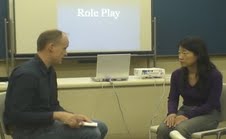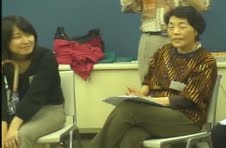[ LLL SIG Website ][ LLL SIG Publications ][ This Issue's Contents ]

Volume 6, Issue 2 [October, 2010]
The Contrast Culture Method Examines
a Teacher-Student Conference
Donna Fujimoto
Osaka Jogakuin College
 |
On Sunday, May 23, 2010, the Contrast Culture Method group gave a workshop at the 9th Annual Pan SIG conference, which was held at Osaka Gakuin University. Since the theme of the conference was "Learner Perspectives," this workshop was entitled: "When Teachers and Students Hold Divergent Views." The session opened with an introduction of the Contrast Culture Method Special Interest Group of SIETAR (Society for Intercultural Education, Training and Research) by the Coordinator, Donna Fujimoto. The Contrast Culture Method is an intercultural training approach which had its beginnings in the 1960s. It was started by Dr. Edward Stewart, a psychologist and a well-known pioneering figure in the field of intercultural communication. |
The CCM SIG was founded in 1999 after a special workshop given by Dr. Stewart in Tokyo. The newly formed group gave its first presentation in the year 2000 and has since given presentations and training sessions at both international and national conferences as well as workshops for teachers and administrators at secondary schools and universities in Japan. There are 28 members from Kansai, Kanto and Chubu with a core of 10 to 12 active members.
The CCM SIG could be more accurately described as a collaborative study group because its members are constantly learning more about CCM as they prepare for their workshops. Their practice sessions provide a sheltered environment where they can delve deeper, often dispensing with tatemae (behavior which is socially required), and asking each other what is really behind their actions. They have found that they can learn more quickly about other people’s cultural understandings through these sessions than multiple years of life experience or study.
| Learning about one's own culture and how it contrasts with other cultures is a constant process. When people feel they have learned all there is to know about another culture, then that is when problems can surface unexpectedly. Fujimoto said that she was drawn to this method because it is empirical, experiential, and collaborative. The work that CCM does is always based on real personal experiences or they stem from incidents that members have observed. People often learn the most when they actually experience something firsthand. The collaborative part of CCM is essential because the approach is such that a single person would not be able to use CCM at all—it requires a group of people. |  |
A group is needed because CCM's key component is the role play. This is not an ordinary role play—it is one where one of the role players has been trained as an actor. This actor, however, does not memorize a script. Instead, s/he plays out a scenario opposite a role player who is from a different, but non-specific culture. The actor (called the Contrast Player) tries to react to the other role player (known as the Reference Player) in a way that brings out the differences between the two of them—not individual differences, but differences due to their cultural background. The Reference player does what s/he finds most natural. If the Contrast player is successful, the Reference player actually experiences roadblocks and unexpected difficulties preventing any smooth interactions.
In the scenario at this workshop, a male teacher was having a conference with a female student because her grades were not good and he thinks she is not working to her full potential. Her classmates have complained that she is not participating enough in their group project and this upsets them because everyone in the group will get the same group grade.
Anthony Ogden was the teacher (Reference player) and Naoko Oka was the student (Contrast player). The Reference player (the teacher) did his best to help the student by giving her the opportunity to talk and bring up any difficulties, The Contrast player (the student) did not give much eye contact, spoke very quietly and diffidently and reported no difficulties at all with her group. As the role play continued, the teacher took out a notebook and tried to list the tasks the student was expected to do in her group, and then enlisted her help in drawing up some suggestions on what she could do to improve her work with the group. The student answered in general statements, such as, "I have to do my best."
In CCM the next segment is an interview of the Reference player by a facilitator, and then the audience members are invited to ask questions as well. This is followed by an interview and audience questions for the Contrast player. Salem Hicks was the facilitator interviewing the teacher, and through her questioning we learned that the teacher felt the teacher-student conference was "exhausting," that the student gave very evasive answers, and that the student was not really aware that there was a problem. Michiko Tomioka was the facilitator for the Contrast player and through the interview we learned that the student had felt very nervous during the conference with the teacher. "My heart is still beating," she confided. She said when speaking with the other members of her group, she often misses her turn to talk because she is busy translating in her head before speaking out.
After the interviews and questions, the workshop moved to a whole group discussion. The audience members drew from their own experiences to talk about what they had just seen. Several said they empathized with the student, and a number of them viewed this incident as perhaps the experience of a study abroad student. One workshop participant pointed out that the general consensus of everyone present was that the student is the one who must change, and she felt that this was detrimental to the student and that her sense of self-worth would be affected. The participant raised the idea that the teacher should try to understand the value that this type of quiet student can bring to the group. A quiet student should not be seen as a failure.
 |
From the CCM point of view, this is exactly the type of comment that is welcomed in a CCM session. A way of thinking that was largely taken for granted by the people present was contrasted with a totally opposite point of view. Unfortunately, there was not enough time for the group to discuss this further, but it certainly provided food for thought. In this type of situation, who must change? Should it be the person from a different culture and the one with less power than all the others? Or should all the people involved become more sensitive to this quiet member? Should everyone make efforts to improve the team work? |
With the workshop session drawing to a close, the role players and the other CCM members were introduced. The role players were so believable that it was necessary to let the workshop participants know their real identities. Then the participants were asked to write an evaluation form, and the coordinator gave an open invitation to those interested to join CCM. The majority of people who stayed until the end of the workshop were involved with study abroad programs, so the interest level in CCM was quite high. Fujimoto said that the workshop had been quite successful, and that the success depended entirely on the great participation of the audience.
If you are interested in learning more about CCM, go to http://ccm.symphonic-net.com/ or contact Donna Fujimoto fujimotodonna@gmail.com